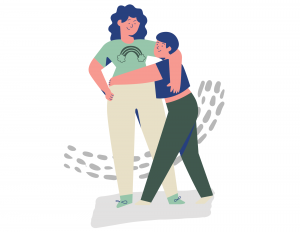How to Be an Ally to the LGBTQIA+ Community
Being an ally and providing your support to the LGBTQIA+ community can help them combat and alleviate the mental health issues previously mentioned, aiding them in achieving a mentally healthy life.

Learning:
-
- The first step in becoming an ally is learning as much as you can about the LGBTQIA+ community.
Listening & showing respect:
-
- You can show your respect by honoring a person’s chosen name and pronouns.
- By simply using someone’s chosen name, suicide ideation decreased by 29% and suicidal behavior decreased by 56%.
- If you accidentally misgender someone, use the wrong pronouns, or someone’s birth name, apologize and commit to doing better in the future.
- You can show your respect by honoring a person’s chosen name and pronouns.

Offering your support:
-
- Having high levels of support from friends and family significantly decreases the risk of suicide attempts.
- LGBTQIA+ youth with highly supportive friends and family are 10% less likely to have attempted suicide in the past year than those with unsupportive friends and family.
- Ask what you can do to help.
- Stand up for the LGBTQIA+ community when it is safe to do so.
- Report any bullying or harassment to the appropriate individuals.
- Having high levels of support from friends and family significantly decreases the risk of suicide attempts.
Being an advocate: 
-
- Help plan, lead, or take part in LGBTQIA+ events and groups to provide support and spread awareness.
- LGBTQIA+ advocacy groups, like GLAAD, offer programs to support LGBTQ youth.
- Attend LGBTQIA+ rallies and Pride with your friends and family members in the community.
- A sense of community and pride has been known to decrease the risk of mental health issues.
- Engage in conversations on LGBTQIA+ equity with your friends, family, and peers.
- Help plan, lead, or take part in LGBTQIA+ events and groups to provide support and spread awareness.
Becoming an activist:
-
- Aid in challenging and dismantling discriminatory practices and policies that may be visible within your own community, school, or workplace.
- Utilize social media to amplify LGBTQIA+ voices and educate your followers.
- Attend and invite others to rallies.
- Reach out to elected officials and advocate for more equitable policies.
- For more information please visit:
- Free2Luv: How To Be An Ally for LGBTQ Youth
- The Trevor Project: A Guide to Being an Ally to Transgender and Nonbinary Youth
- The Trevor Project: Preventing Suicide: How You Can Help
- The Trevor Project: National Survey on LGBTQ Youth Mental Health 2020.
How to Help Someone in Crisis
The following video provides steps you can take to help someone in crisis if you notice they are displaying the warning signs or any risk factors of suicide.
